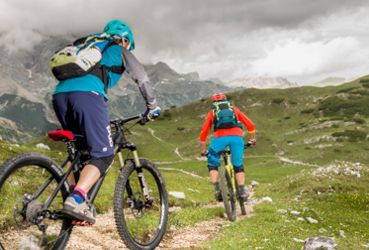The 6 commandments for fair biking
Biking with respect for the trails and the environment is not an art. If you follow these simple rules, you contribute to minimising the maintenance works and costs, and help take the wind out of the sails of MTB critics.

Stop Riding Dirty
Please wash your bike in-between tours, especially if you've cycled on a dusty or wet trail. This is not to make your bike look nicer, but because flower seeds can be contained in all that dirt, and they belong in the place where you originally found them!
Stop Roosting Corners
For once and for all: blocking your brakes before and in turns is an absolute no-go! This means, you will have to use your brakes sooner or later, especially if there is no berm to support you in the turn. You can however brake in a gentle way long before the turn approaches. This is a great way to preserve the trail.
Stop Riding Around
Whenever it gets too technical, there are two things mountain-bikers do: they either get off the bike or cycle around the difficult spot. The latter is not good. Why not? Every detour makes the trail wider and creates completely new lines. This increase in lines creates problems and is disadvantageous for the forest. So either get off the bike or take the hurdle as it is. That's only fair!
By the way, "stop riding around" is also valid for puddles. It is better to just cycle through them. This behaviour preserves the original shape of the trail, and avoids the trail getting wider and wider after every rainfall.
Stop Riding in Mud
Of course it can happen that you might get wet or end up in a storm. It is however gross negligence to look for the most beautiful single trails with beautiful soil in the forest whenever it is wet or muddy. Why? Because the entire humus, which is the soil with needles and moss, sticks to the tires and the softness that we love about single trails, will disappear. Hence: Whenever there are muddy conditions either stay at home or cycle on laid-out MTB trails, which have a processed underground.
Stop Riding Fall Lines
The fall line is always the fastest and most direct line. This line might be great for downhill bikers in a race, but not for mountain-bikers who respect the environment. The steeper the trail, the more erosion. The IMBA recommends not creating trails steeper than a 10% inclination. Many hiking trails in the Alps are however steeper, and therefore more sensitive. Especially valid here: avoid aggressive braking and additional short-cuts!
Stop Cutting Switchbacks
Doing switchbacks. The supreme discipline of mountain-bikers. Not everyone knows ten different variations of cycling switchbacks as smoothly as Tom Öhler. Quite the opposite! For many, this balancing act results in a fall or cheat, for example by cutting the turns. What's the result? Nothing but worn-off humus and an unwanted gutter, which might protect the turn from water, but which thins away the trail beneath.
www.singletracks.com

Stop Riding Dirty
Please wash your bike in-between tours, especially if you've cycled on a dusty or wet trail. This is not to make your bike look nicer, but because flower seeds can be contained in all that dirt, and they belong in the place where you originally found them!
Stop Roosting Corners
For once and for all: blocking your brakes before and in turns is an absolute no-go! This means, you will have to use your brakes sooner or later, especially if there is no berm to support you in the turn. You can however brake in a gentle way long before the turn approaches. This is a great way to preserve the trail.
Stop Riding Around
Whenever it gets too technical, there are two things mountain-bikers do: they either get off the bike or cycle around the difficult spot. The latter is not good. Why not? Every detour makes the trail wider and creates completely new lines. This increase in lines creates problems and is disadvantageous for the forest. So either get off the bike or take the hurdle as it is. That's only fair!
By the way, "stop riding around" is also valid for puddles. It is better to just cycle through them. This behaviour preserves the original shape of the trail, and avoids the trail getting wider and wider after every rainfall.
Stop Riding in Mud
Of course it can happen that you might get wet or end up in a storm. It is however gross negligence to look for the most beautiful single trails with beautiful soil in the forest whenever it is wet or muddy. Why? Because the entire humus, which is the soil with needles and moss, sticks to the tires and the softness that we love about single trails, will disappear. Hence: Whenever there are muddy conditions either stay at home or cycle on laid-out MTB trails, which have a processed underground.
Stop Riding Fall Lines
The fall line is always the fastest and most direct line. This line might be great for downhill bikers in a race, but not for mountain-bikers who respect the environment. The steeper the trail, the more erosion. The IMBA recommends not creating trails steeper than a 10% inclination. Many hiking trails in the Alps are however steeper, and therefore more sensitive. Especially valid here: avoid aggressive braking and additional short-cuts!
Stop Cutting Switchbacks
Doing switchbacks. The supreme discipline of mountain-bikers. Not everyone knows ten different variations of cycling switchbacks as smoothly as Tom Öhler. Quite the opposite! For many, this balancing act results in a fall or cheat, for example by cutting the turns. What's the result? Nothing but worn-off humus and an unwanted gutter, which might protect the turn from water, but which thins away the trail beneath.
www.singletracks.com





